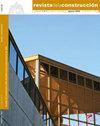Evaluating the durability of recycled concrete made of coarse recycled aggregate concrete containing silica-fume and natural zeolite
IF 1.4
4区 工程技术
引用次数: 5
Abstract
This experimental study evaluates the durability of recycled aggregate concrete (RAC) containing silica-fume (SF) and natural zeolite (NZ). For this purpose, four levels of recycled coarse concrete aggregates (RCA) were replaced with natural coarse aggregates (NCA). To compare the effect of pozzolans, three levels of SF (5%, 10%, and 15%) and three levels of NZ (10%, 20%, and 30%) were replaced with cement. To evaluate the durability of RAC, 28 mixed designs were made and the following were measured: compressive strength (CS), water absorption by immersion (WA by immersion), water absorption by capillary (WA by capillary), electrical resistance (ER), electrical conductivity (EC) and rapid chloride penetration test (RCPT). The results indicated that WA by immersion and WA by capillary of RAC increased with enhanced RCA incorporation. On the other hand, the pozzolanic reaction of 10% of SF and 10% of NZ decreased capillary pores and structural weakness of full-scale RAC. However, due to the internal chemical changes of RAC, contrary to the WA by immersion and WA by capillary, compared to conventional concrete (CC), a lower EC and unchanged ER values of RC100 containing pozzolans were seen. The scanning electron microscopy (SEM) revealed that compared to NZ, a 10% of SF significantly improved the microstructure of full scale RAC.含硅灰和天然沸石的粗再生骨料混凝土的耐久性评价
本实验研究评估了含硅灰(SF)和天然沸石(NZ)的再生骨料混凝土(RAC)的耐久性。为此,四个级别的再生粗混凝土骨料(RCA)被天然粗骨料(NCA)所取代。为了比较火山灰的效果,用水泥代替了三种级别的SF(5%, 10%和15%)和三种级别的NZ(10%, 20%和30%)。为了评价RAC的耐久性,制作了28种混合设计,并对其抗压强度(CS)、浸水吸水性(WA by immersion)、毛细吸水性(WA by毛细管)、电阻(ER)、电导率(EC)和快速氯化物渗透试验(RCPT)进行了测试。结果表明,随着RCA掺入量的增加,浸渍法和毛细管法的WA均增加。另一方面,10%的SF和10%的NZ的火山灰反应减少了全尺寸RAC的毛细孔隙和结构弱点。然而,由于RAC的内部化学变化,与浸渍WA和毛细WA相反,与常规混凝土(CC)相比,含有火山灰的RC100的EC值较低,ER值不变。扫描电镜(SEM)显示,与NZ相比,10%的SF显著改善了全尺寸RAC的微观结构。
本文章由计算机程序翻译,如有差异,请以英文原文为准。
求助全文
约1分钟内获得全文
求助全文
来源期刊

Revista de la Construccion
工程技术-工程:土木
CiteScore
2.30
自引率
21.40%
发文量
0
期刊介绍:
The Journal of Construction is aimed at professionals, constructors, academics, researchers, companies, architects, engineers, and anyone who wishes to expand and update their knowledge about construction. We therefore invite all researchers, academics, and professionals to send their contributions for assessment and possible publication in this journal. The publications are free of publication charges.
OBJECTIVES
The objectives of the Journal of Construction are:
1. To disseminate new knowledge in all areas related to construction (Building, Civil Works, Materials, Business, Education, etc.).
2. To provide professionals in the area with material for discussion to refresh and update their knowledge.
3. To disseminate new applied technologies in construction nationally and internationally.
4. To provide national and foreign academics with an internationally endorsed medium in which to share their knowledge and debate the topics raised.
 求助内容:
求助内容: 应助结果提醒方式:
应助结果提醒方式:


